Helicocranchia
Piglet squid
Richard E. Young and Katharina M. Mangold (1922-2003)Helicocranchia contains three recognized species. Voss, et al. (1992), however, suggest that as many as 14 species may exist.
- Helicocranchia pfefferi
- Helicocranchia papillata
- Helicocranchia joubini
Introduction
Species of Helicocranchia are small, oceanic squid (100 mm ML) characterized by having a very large funnel and small paddle-like fins that attach to a portion of the gladius that rises above the muscular mantle. They exhibit a gradual ontogenetic descent from near-surface waters as paralarvae to lower mesopelagic depths as near-adults.
Brief diagnosis:
A taoniin...
- with exceptionally large funnel relative to head and arms.
- with fins which project dorsally in advance of mantle apex.
Characteristics
- Arms
- Tentacles
- Clubs with suckers only.
- Tentacular stalks with two series of suckers and pads nearly to stalk base.
- Funnel
- Funnel valve absent.
- Funnel organ: Dorsal pad with 3 slender papillae.
- Funnel extremely large.
- Mantle
- Tubercles absent from funnel-mantle fusion.
- Fins
- Fins paddle shaped.
- Fins insert on short rostrum of gladius which projects dorsally in advance of mantle apex (photographs below).*
- Photophores
- Single ocular photophore. (Difficult to detect in some species.)
- Arm-tip photophores absent.
 Click on an image to view larger version & data in a new window
Click on an image to view larger version & data in a new window
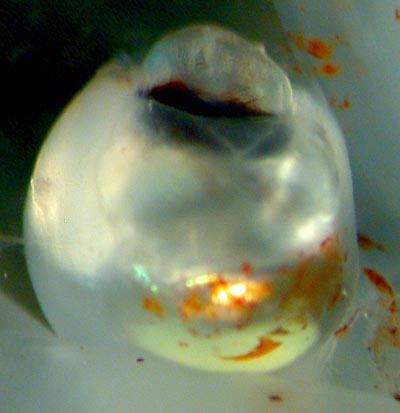
Figure. Left - Posterior and lateral views of the ocular photophore of H. papillata, 60 mm ML. Drawings from Voss, 1980, p. 383. Right - Ventral view of an eye of H. pfefferi showing the yellowish ocular photophore on the medial face of the eye, 35 mm ML. Photographed aboard the R/V G. O. SARS, Mar-Eco cruise, central North Atlantic by R. Young.
Comments
One of the most distinctive features of this genus is the extremely large funnel that extends well beyond the beaks. This feature, which recalls the large snout of a pig, gives the squid its common name. Characteristics are from Voss (1980).
Life History
The large funnel is present in the paralarva and makes generic identification of paralarvae easy. There is a near absence of an optic stalk making the eyes nearly sessile.

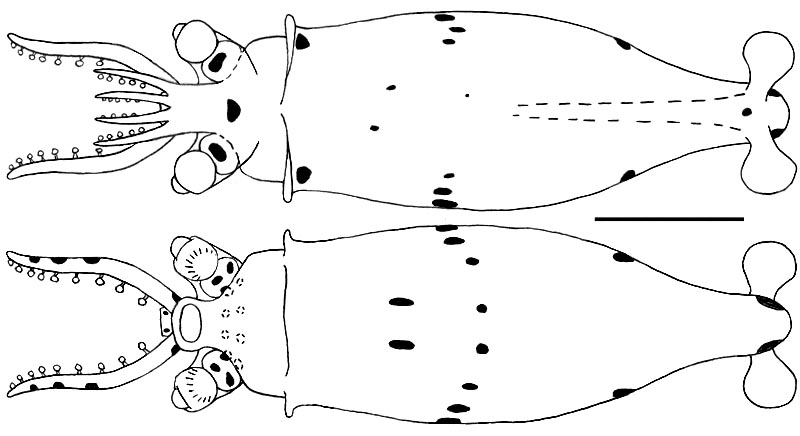
Figure. Dorsal and ventral views of a paralarva of H. pfefferi, 3.4 mm ML, Hawaiian waters. Drawings by R. Young. The scale bar is 1 mm.
With increased age and depth of occurrence, Helicocranchia, becomes reddish in color probably as they start to mature sexually. Near sexual maturity many cranchiids apparently lose their tentacles. The insitu ROV images on the right below show that loss of tentacles is, indeed, normal.

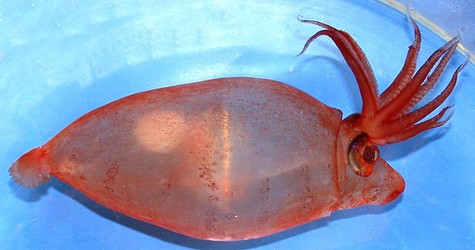
Figure. Left - Side view of H. pfefferi, central North Atlantic, female, 63 mm ML. Note the color and the absence of tentacles. Photographed aboard the MarEco cruise of the R/V G.O. SARS by R. Young. Right - two Insitu photographs of the same female Helicocranchia sp, anterolateral views, from an ROV photographed floating in front of oil pumping equipment in the Gulf of Guinea at a depth of 1015 m (SERPENT project). Arrow in upper photograph points to stub of tentacle.
Distribution
Vertical distribution
The distribution of Helicocranchia pfefferi from Hawaiian waters shows a clear pattern of ontogenetic descent with squid occurring in progressively deeper water as they get larger. Diel vertical migration does not seem to occur in this species. The dominance of nighttime captures for young stages is a result of the low sampling effort in shallow depths during the daytime and doesn't indicate the daytime absence of small squid at these depths.
Figure. Vertical distribution chart of H. pfefferi, Hawaiian waters. Captures were made with both open and opening/closing trawls. Bars- fishing depth-range of opening/closing trawl. Circle- Modal fishing depth for either trawl. Blue-filled circles- Night captures. Yellow-filled circles- Day capture. Chart modified from Young (1978).
In the Atlantic Lu and Clarke (1975) show a similar vertical distribution pattern for Helicocranchia pfefferi. Most captures at less than 30 mm ML were made between 100 and 200 m. Around 30 mm ML an ontogenetic descent began although their largest specimen (49 mm ML) was taken between 300 and 400 m. Presumably the size/depth trend would continue for larger individuals.
Geographical distribution
Species occur throughout the world's tropical and subtropical oceans and, in the Atlantic Ocean, in north temperate waters (Voss, 1992).
References
Lu, C. C. and M. R. Clarke, 1975. Vertical Distribution of Cephalopods at 11° N 20° W in the North Atlantic. Journal of the Marine Biological Association of the United Kingdom, 55 (2): 369-389.
Voss, N. A. 1980. A generic revision of the Cranchiidae (Cephalopoda; Oegopsida). Bull. Mar. Sci., 30: 365-412.
Voss N. A., S. J. Stephen and Zh. Dong 1992. Family Cranchiidae Prosch, 1849. Smithson. Contr. Zool., 513: 187-210.
Young, R. E. 1972. The systematics and areal distribution of pelagic cephalopods from the seas off Southern California. Smithson. Contr. Zool., 97: 1-159.
Young, R. E. (1978). Vertical distribution and photosensitive vesicles of pelagic cephalopods from Hawaiian waters. Fish. Bull., 76: 583-615.
Title Illustrations

| Scientific Name | Helicocranchia pfefferi |
|---|---|
| Location | off Southern California |
| View | lateral |
| Copyright | © 1996 Donald Bright |
| Scientific Name | Helicocranchia pfefferi |
|---|---|
| Location | Off Southern California |
| Reference | from Young, R. E. 1972. The systematics and areal distribution of pelagic cephalopods from the seas off Southern California. Smithson. Contr. Zool., 97: 1-159. |
| View | Ventral |
| Size | 41 mm ML |
| Image Use |
 This media file is licensed under the Creative Commons Attribution License - Version 3.0. This media file is licensed under the Creative Commons Attribution License - Version 3.0.
|
| Copyright |
©

|
About This Page

University of Hawaii, Honolulu, HI, USA
Katharina M. Mangold (1922-2003)

Laboratoire Arago, Banyuls-Sur-Mer, France
Page copyright © 2014 and Katharina M. Mangold (1922-2003)
 Page: Tree of Life
Helicocranchia . Piglet squid.
Authored by
Richard E. Young and Katharina M. Mangold (1922-2003).
The TEXT of this page is licensed under the
Creative Commons Attribution-NonCommercial License - Version 3.0. Note that images and other media
featured on this page are each governed by their own license, and they may or may not be available
for reuse. Click on an image or a media link to access the media data window, which provides the
relevant licensing information. For the general terms and conditions of ToL material reuse and
redistribution, please see the Tree of Life Copyright
Policies.
Page: Tree of Life
Helicocranchia . Piglet squid.
Authored by
Richard E. Young and Katharina M. Mangold (1922-2003).
The TEXT of this page is licensed under the
Creative Commons Attribution-NonCommercial License - Version 3.0. Note that images and other media
featured on this page are each governed by their own license, and they may or may not be available
for reuse. Click on an image or a media link to access the media data window, which provides the
relevant licensing information. For the general terms and conditions of ToL material reuse and
redistribution, please see the Tree of Life Copyright
Policies.
- Content changed 21 January 2014
Citing this page:
Young, Richard E. and Katharina M. Mangold (1922-2003). 2014. Helicocranchia . Piglet squid. Version 21 January 2014 (under construction). http://tolweb.org/Helicocranchia/19550/2014.01.21 in The Tree of Life Web Project, http://tolweb.org/




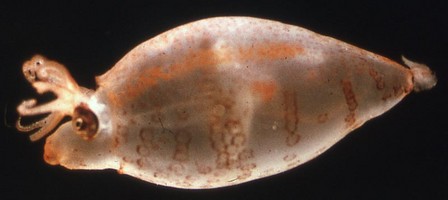

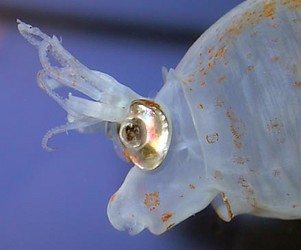
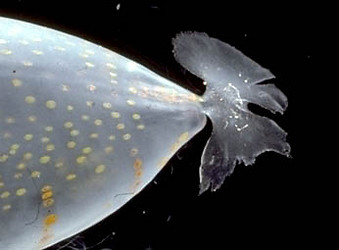
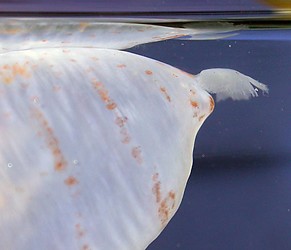




 Go to quick links
Go to quick search
Go to navigation for this section of the ToL site
Go to detailed links for the ToL site
Go to quick links
Go to quick search
Go to navigation for this section of the ToL site
Go to detailed links for the ToL site